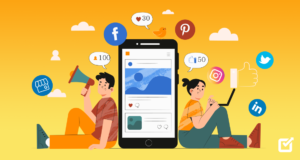How to choose your marketing communication channels?

Marketing communication channels are the various means by which a business can communicate with its target audience to promote its products or services, build brand awareness and credibility, and build long-term relationships with its customers. Which channels to choose? Here is our guide.
Build multiple communication channels
There is a wide variety of marketing communication channels available, ranging from traditional channels, such as press announcements, radio announcements or display in street furniture, but also a wide variety of digital communication channels, such as social networks or online advertising. Each communication channel has its advantages and disadvantages, and it is important to choose the most appropriate channels according to the company’s strategy, its communication objectives and its target audience. A point that we will explore a little later in this article.
In marketing, each communication channel is also called a “touchpoint”, and it is estimated that to maintain long-term visibility and succeed in making your brand known to your customer, it is necessary to maintain 7 communication points to achieve a successful long-term retention. Of course, not all companies have the means to maintain 7 touchpoints with the same intensity. At SEO BRISK, we regularly remind you that it is better to maintain one or two communication channels and do it very well, rather than scattering over your communication strategy and not getting any results.
Below, the graphic details the communication channels you could have with your customer. As you can see, engaging in physical networking, or having an up-to-date Google My Business account are all communication points you can nurture without investing too heavily in communication.
But these points of communication will not be enough and to take a step forward in terms of notoriety and promotion of your services, you will have to think about investing in other communication channels on a larger scale, such as digital communication or on traditional as press announcements.
How to choose your marketing communication channels
To choose your communication channels, we will focus on three criteria:
- What is the communication budget that you are able to invest?
- Is the customer actively looking for a product like mine?
- Is my product a consumer product or a niche product?
- Are we trying to build awareness or reach a customer who is ready to buy?
And when we have established how your company is positioned on these three criteria, we will choose your communication channels appropriately, by selecting one or more contact points that will meet your objective(s).
Online communication channels
We will discuss the example of several online communication channels such as social networks, online advertisements, email marketing, blogs etc. These are all online communication channels that can be used to reach a wider audience, build brand awareness and drive sales. Let’s see how to use them wisely as part of a communication strategy.
Social networks
Social networks such as Facebook, Twitter, Instagram and Tik Tok allow companies to communicate directly with their target audience, share visual and interactive content, and create online communities. Social networks are mainly used for consumer products and services, when the customer is not actively searching. These are therefore communication channels that are used to generate notoriety and create what is called “brand recognition”. They will allow you to build – in the medium or long term – committed communities likely to adhere to the values of your company and ultimately to buy your products or services.
LinkedIn is a bit apart in the world of social networks. This professional social network responds to a slightly different use, since we will rather use it to maintain its notoriety with a more specific target, while the other social networks have a more general public vocation. LinkedIn is an excellent developer of opportunities for a B2B company, whether through a LinkedIn communication strategy, or through a sales prospecting service on LinkedIn. It is therefore an example of a communication channel that naturally stands out among the best channels for B2B professionals.
Online advertising
Online advertisements, such as Google ads and social media ads, can help target specific audiences based on their age, gender, geographic location and interests. These communication channels are aimed at a clientele that is more of a general public and in active search. When the customer knows what he wants, it is therefore relevant to activate communication channels that will allow him to find your products easily.
SEO
Natural referencing is also a very powerful way to reach customers in active search. By placing yourself in the first Google search results, you are giving yourself the opportunity to reach a large pool of customers who do not yet know you. In the long term, natural referencing is one of the communication channels that bring the best return on investment. Among the levers of natural referencing, there is in particular the use of the blog. Blogs can help establish a company’s expertise in its field and attract visitors to its website. But a natural referencing strategy cannot be improvised. To succeed in your development on this communication channel, you can call on a natural referencing agency like SEO BRISK which will know how to structure and manage your project.
Mailing strategies (inbound and outbound)
We use mailings (newsletters, prospecting by email) to reach highly targeted customers who are not actively looking. It is therefore to arouse the interest of the prospect, to accompany him in his journey of discovery of the product, until his need emerges.
Some Disadvantages of Online Communication Channels
It should be noted that online communication channels also have their drawbacks. Initially, there is extremely strong competition between all the creators and all the brands. The online environment is saturated, so it is essential to know how to stand out to develop the notoriety of your company online. On the other hand, online advertisements can be blocked or ignored by users. Businesses also need to be careful not to be overly intrusive or send unwanted emails that could damage their reputation.
Traditional communication channels (or offline channels)
Traditional communication channels, such as in-store advertising, public relations and events, continue to be used to promote businesses. These channels have been used for a long time and remain very useful for developing your brand and your customer base, even if their impact is more difficult to measure. Let’s look at some examples of traditional communication channels
Events and trade fairs
Events, such as trade shows and store openings, can be used to meet potential customers in person and build relationships. For example, a car dealership will organize open days to allow the general public to come and meet it, discover its products or even formalize an order. But it will also be possible to organize private events, in small groups with only a few customers. In this context, the objective is rather to consolidate a customer relationship or to maintain a privileged link with an important customer. There are therefore several examples of uses of a communication channel such as events: either in a logic of customer conquest, or in a logic of loyalty.
Urban advertising (bus shelters, displays in the tram, metro, etc.)
Urban advertising can help grab the attention of potential customers walking the streets and can be used to promote special offers or upcoming events. The objective is therefore above all to create notoriety, and these are strategies that are also used seasonally. For example, the holiday season will be very conducive to urban display for perfumes, chocolates and other festive products, when the potential customer is most likely to be interested in them.
Press announcements and television advertising
Wix SEO expert see that traditional media are mainly used for products and services for the general public, when the customer is not actively searching. These are therefore communication channels that are used to generate notoriety and create what is called “brand recognition”. We can, however, select specialized press titles that will make it possible to address a more specialized niche clientele. But keep in mind that these traditional communication channels can be more expensive than online communication channels and their effectiveness can be harder to measure. It’s important for companies to determine if these channels are relevant to their target audience and choose events and PR initiatives that reflect their brand image.
Ultimately, the marketing communication channels a company uses will depend on its communication strategy, budget, and target audience and business goals. Businesses need to take a strategic approach and regularly measure the results of their marketing initiatives to determine which channels are most effective in achieving their goals.
Hybrid communication channels
The use of offline and online communication channels can be complementary for companies. Businesses can leverage the reach and flexibility of online communication channels to reach wider audiences, while offline communication channels can help build credibility and customer proximity. The combination of traditional communication and online communication defines so-called “hybrid communication channels”.
By combining offline and online communication channels, businesses can create a cohesive brand experience and strengthen their presence across multiple channels. However, it is important to plan and execute a communication strategy in a relevant and planned way, not in an opportunistic way. The most successful companies in terms of communication are those that have best planned their strategy and defined the best indicators of success.
Ultimately, a company’s communications strategy must be tailored to its business goals and target audience. And a good communication strategy will respond to the following seven steps:
- We will promote this product
- By targeting someone
- One using THIS specific message
- On the following channels that we will use for such and such a reason
- That we will use at such recurrence
- With this budget
- AND we will measure the results with indicators A, B, C and D.
It’s our job and we have supported dozens of companies in the structuring and execution of their communication strategy. Do not hesitate to contact us if you want to deepen your project and get your communication off the ground.
Conclusion: communication channels to get your business off the ground
In conclusion, marketing communication channels provide businesses with a variety of options and opportunities to reach their target audience, promote their brand and generate sales.
By combining offline and online communication channels, businesses can create a cohesive brand experience and reach their target audience effectively. However, it is important to plan and execute these channels in a consistent and thoughtful manner to maximize their impact and avoid any confusion or dissonance in corporate communication. Hence the importance of defining a solid communication strategy.
Ultimately, companies need to determine which marketing communication channels are best suited to their communication strategy, budget and target audience. By regularly measuring the results of their marketing initiatives, companies can adjust their strategy to maximize their impact and achieve their business goals.








